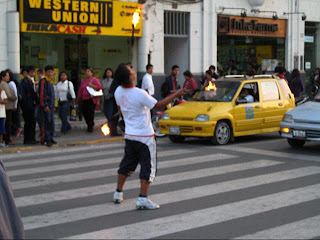My friend Krissy Morrow recently visited me from Austin, Texas. She took a trip to Machu Picchu and has some really good tips for visiting the sacred city of the Incas.
Getting to Machu Picchu
Traveling to Machu Picchu will require at minimum
- One hour plane ride or 24 hour bus ride to Cuscu
- 3 hour train ride to Aguascalientes/ or 1.5 hour ride in colectivo (minibus) and 1.5 hour train ride
- 30 minute bus or 1 hour walk up mountain to Machu Picchu.
Option 1: You have a ton of money. Get the tour package. Everything will be handled for you. Make sure hotel is nice and has heat in Cusco and is not near center of town in Aguascalientes (it’s loud there)
Option 2: cheaper option. Use tour agencies to buy air tickets, train tickets from ollantaybayo, and tickets to machu picchu with tour (the latter two you only need to buy in advance during busy season). You will need to buy on your own: transport from airport to cusco (take a bus), hotel in cusco (or ollantaybayo), colectivo (minivan) to ollantaybayo and back, bus ticket up machu picchu (unless you want to walk up and down), hotel for the way back (in cusco if you have an early flight back.
Option 3: If you have lots of time and are on a budget, there is a 24 hour bus ride to Cuzco. You save about half on airfare. Take only the luxury bus- it has reclining seats. Follow option 2 for everything else.
At the park of Machu Picchu
- Water. They say you can’t bring it in. You can. Bring a reusable bottle to be safe. However, keep in mind, that they charge to use the bathroom and you have to go all the way back to the park entrance. The best method is to hydrate well the day before, DO NOT GO OUT DRINKING the night before, and drink little water throughout the day.
- Food. The café charges $5 for a hot dog and it’s a nasty hot dog, and you have to go all the back to the entrance to get it. Bring food that does not make you thirsty (i.e. no salt crackers, but fruit is great). You can buy both food and water at bus station in aguacalientes- there is a market that opens early. Whatever they charge you is will be less than half of what machu picchu café charges.
- Layered clothing. Don’t bring a heavy jacket. You will take if off by 8am and be stuck with it all day. Wear at least three layers of clothing. I was down to a tank top by noon (it was sunny when I went- I understand it can be cooler). If it’s cloudy, consider gloves/hat and 4-5 layers.
- Walking/hiking shoes. No flip flops!
- They say insect repellant and sunscreen . I was ok without it.
- A camera! Make sure battery is charged (or you have extra batteries) and you have lots of room for pictures!
- You can leave you luggage at hotel, even if you are checking out.
- Hat and sunglasses for sunny days
- Passport. They do require ID. Investigate if they will take a copy of passport and a driver’s license because it’s risky to travel with a passport.
- Money. In case the $5 dry, flavorless hot dog appeals to you. DO NOT BUY souvenirs there. Everything is available at a fraction of the cost in Aguascalientes or Cusco (cheaper).


Arrive at bus station at about 6 am in order to make it to machu picchu park by about 7:10 and see sunrise (this time varies). During high season you will wait at bus station about 15 minutes and to get in park about 30 minutes. If you do this option, you will have to walk down about 10 flights of stairs to go back to the park entrance to meet your tour guide. Recommended if you really like sunrises (see below)
Leave about 7am to get to park at 7:45 to meet your tour guide. Don’t wait in line at all. Sleep in and get to park whenever (maybe go to hot springs at Aguascalientes). Get a private tour guide at entrance. This may work if you have a late train back or you are staying the night in Aguascalientes. You must pick a hotel with thick walls because everyone will be up early anyway, waking you up. Not recommended.
A note about Aguascalientes:
This is a SUPER tourist driven town. They will try to scam you at every corner. Here at some tricks. Many restaurants add a “tax” of about 6 soles to every bill. They will claim drinks are 4X1, give you small drinks, then point to a sign that says happy hour is 20 soles (when one drink is 10 soles on the menu) and charge you 26 soles (20 happy hour +6 tax). My suggestion is to order, then ask to see the bill before they bring you anything (“Quiero ver la cuenta antes de que nos traiga las bebidas y la comida). You may not understand the waiters response but just keep repeating that phrase.
The market by the train station is overpriced. The market by the bus station is a little more reasonable. Cusco is much more reasonable. Lima is even more reasonable.













































